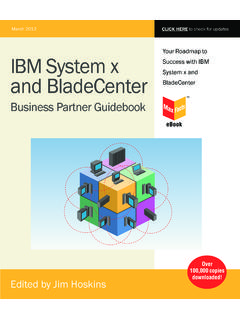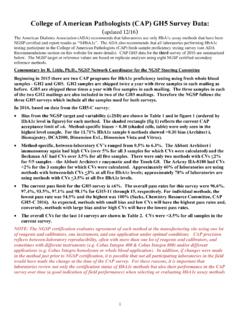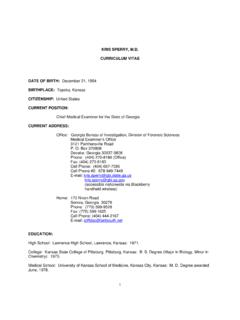Transcription of Benefiting From Bedside Specimen Labeling - Ingram Micro
1 A Zebra Technologies White PaperBenefiting From BedsideSpecimen Labeling2A Zebra Technologies White Paper3A Zebra Technologies White PaperExecutive SummaryLabeling blood and other samples at the time they are collected improves patient safety and helps prevent a host of problems related to misidentification including many of the estimated 160,900 adverse events that occur in hospitals annually because of sample identification There is a strong and growing body of evidence within medical literature that creating Specimen identification labels on demand at the patient Bedside with a mobile printer can significantly reduce errors. The Joint Commission s National Patient Safety Goals (NPSG) for 2010 advocate the use of two patient-specific identifiers, such as name and birthdate, whenever taking blood or other samples from a patient, and to label the sample collection container in the presence of the patient.
2 Producing Specimen labels at the patient Bedside and encoding patient identification in a bar code satisfies both The Joint Commission s NPSG and Health Insurance Portability and Accountability Act (HIPAA) requirements. This white paper explains the point-of-care Specimen Labeling process, documents its benefits, outlines equipment and IT requirements, and provides tips for successful the Problem and OpportunityImproved patient safety and care are the main reasons to implement mobile Specimen collection Labeling . Misidentified samples create a serious risk to patient safety by leading to misdiagnosis and inappropriate treatment. In fact, one of the root causes of wrong site surgery is the switching, mislabeling or incorrect display of test specimens or results, which accounts for 12 percent of wrong site surgeries The case of Linda McDougal, a Wisconsin woman who underwent an unnecessary double mastectomy because her biopsy sample had been confused with another, drew national attention to the problem of sample identification errors and their McDougal s experience is dramatic, but not isolated.
3 According to one study, one in 18 sample identification errors leads directly to an adverse study found percent of phlebotomy samples are It is becoming increasingly clear that sample misidentification, which can lead to misdiagnosis, unnecessary treatment and wasteful tests, is a problem with serious patient safety consequences. There is also a significant financial impact. For example, it is estimated that the cost of misidentified specimens adds up to approximately $280,000 per million One study determined that the redraws, retesting and additional treatment required due to sample errors costs hospitals an estimated $200 to $400 million per 1,4. Paul N. Valenstein, MD; Stephen S.
4 Raab, MD; Molly , PhD Identification Errors Involving Clinical Laboratories: A College of American Pathologists Q-Probes Study of Patient and Specimen Identification Errors at 120 Institutions, Archives of Pathology and Laboratory Medicine: Vol. 130, No. 8, pp. 1106 1113. 2. Richard J. Croteau, , Wrong Site Surgery: The Evidence Base. New York State Patient Safety Conference, 2007. 3. Accessed from on November 14, 2006: 5. Giuseppe Lippi, Gian Luca Salvagno,Martina Montagnana, Massimo Franchini, Gian Cesare Guidi, Phlebotomy Issues and Qual-ity Improvement in Results of Laboratory Testing, Clin. Lab. 5+6/2006. 6. Valenstein PN, Raab SS, Walsh MK. Identification errors involving clinical laboratories: a College of American Pathologists Q-Probes study of patient and Specimen identification errors at 120 institutions.
5 Arch Pathol Lab Med. 2006;130:1106 1113. 7. Bologna L, Hardy G, Mutter M. Reducing Specimen and medication error with handheld technology. Presented at 2001 Annual Conference and Exhibition. Healthcare Information and Management Society, Feb 4-8, 2001, Chicago, IL, cited by Margaret Herrin in A Pledge of Safety: How one laboratory automated its Specimen collection process to increase productivity, streamline work-flow and improve patient care. ADVANCE for Administrators of the Laboratory, October Zebra Technologies White PaperWhy Label at Collection?Accurate Labeling at the point of care can prevent many Specimen identification errors and resulting problems. Specimen Labeling errors accounted for percent of identification errors in a study conducted by the College of American Specimen Labeling , the most common error, occurred more than twice as much as the second-most common cause.
6 In addition, an analysis of adverse events that occurred at the Veterans Health Administration from 2000 to 2008 revealed that Specimen Labeling errors during the collection process accounted for nearly 37 percent of the adverse By accurately identifying samples, hospitals can eliminate a leading source of identification more time and distance between when labels are produced and when they are applied, the greater the chances they will be put on the wrong sample. For example, prior to converting from centralized printing to Bedside Specimen Labeling , the staff at The Valley Hospital in Ridgewood, , identified 63 steps in its phlebotomy collection process where errors could occur. Labeling specimens at the patient Bedside eliminated 44 of these steps from the process.
7 After implementing the Bedside Labeling system, The Valley Hospital reported zero misidentified patients and specimens, zero incorrect Specimen containers and zero unnecessary phlebotomies after six months and 8,000 The hospital also analyzed Specimen identification errors and found that carrying multiple labels into a patient room was the leading cause of Specimen mislabel-ing. Labeling away from the Bedside was the second-leading reasons for creating processes to prevent Specimen Labeling errors are clear. So is the value of Bedside Labeling for Specimen identification. Numerous other studies and anecdotal results have shown the practice to be highly effective. Becton Dickinson reported that studies by two of the hospitals that installed its system for positive patient identification and Specimen collection found nearly a 100 percent reduction in Specimen collection Similarly, after Beloit Memorial Hospital implemented a Specimen collection verification system, the hospital experienced a significant decline in wrong-patient errors related to Specimen Many other hospitals and laboratories have reported significant error reductions related to bar code-based patient and Specimen identification and point-of-care Joint Commission 2010 Na-tional Patient Safety Goal (NPSG).
8 Use at least two patient identifiers when providing care, treatment, and Rationale: Wrong-patient errors occur in virtually all stages of diagnosis and treatment. The intent for this goal is two-fold: first, to reliably identify the indi-vidual as the person for whom the service or treatment is intended; second, to match the service or treatment to that individual. Therefore, the two patient/client/resident-specific identifiers must be directly associated with the individual and the same two identifiers must be directly associated with the medications, blood products, Specimen contain-ers (such as on an attached label), other treatments or of Performance for : Use at least two patient identifiers when administer-ing medications, blood, or blood components; when collecting blood samples and other speci-mens for clinical testing; and when providing treatments or proce-dures.
9 Label containers used for blood and other specimens in the presence of the patient. Pro-cesses are established to maintain samples identity throughout the pre analytical, analytical and post-analytical processes. (Applicable to Joint Commission accredited laboratories)Implementation Expectations for : Timely and ac-curate Specimen Labeling ensures the correct patient identification from collection through results reporting. The two identifiers may be in the same location, such as a wristband. It is the person-specific information that is the identifier, not the medium on which that information resides. Acceptable identifiers may be the individual s name, an assigned identification number, telephone number, or other person-specific identifier.
10 The patient s room number or physical location is not used as an identifier. Electronic identification technology coding, such as bar coding or RFID, that includes two or more person-specific identifiers will comply with this requirement. Source: Commission 2010 National Patient Safety Goals Implementation Expectations. 8. Paul N. Valenstein, Stephen S. Raab, Molly K. Walsh (2006) Identification Errors Involving Clinical Laboratories: A College of American Pathologists Q-Probes Study of Patient and Speci-men Identification Errors at 120 Institutions. Archives of Pathology & Laboratory Medicine: Vol. 130, No. 8, pp. 1106-1113. 9. Edward J. Dunn, Paul J. Moga (2010) Patient Misidentification in Laboratory Medicine: A Qualitative Analysis of 227 Root Cause Analysis Reports in the Veterans Health Administration.










